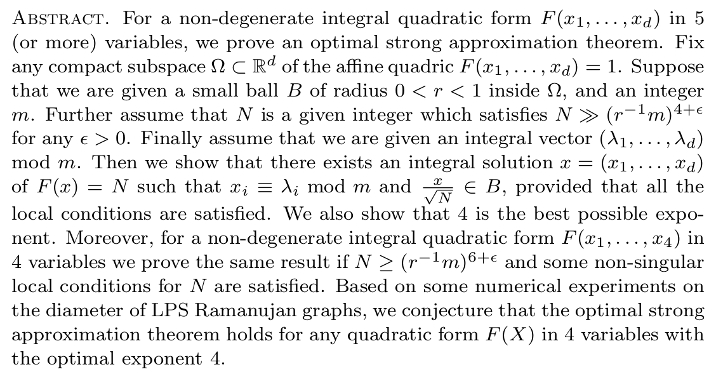NTS ABSTRACT: Difference between revisions
(→Mar 17) |
(→Mar 17) |
||
| Line 88: | Line 88: | ||
| bgcolor="#F0A0A0" align="center" style="font-size:125%" | '''Jinhyun Park''' | | bgcolor="#F0A0A0" align="center" style="font-size:125%" | '''Jinhyun Park''' | ||
|- | |- | ||
| bgcolor="#BCD2EE" align="center" | '' | | bgcolor="#BCD2EE" align="center" | ''Algebraic cycles and crystalline cohomology'' | ||
|- | |- | ||
| bgcolor="#BCD2EE" | | | bgcolor="#BCD2EE" | | ||
Revision as of 16:13, 8 March 2016
Return to NTS Spring 2016
Jan 28
| Nigel Boston |
| The 2-class tower of Q(√-5460) |
|
What is the liminf of the root-discriminants of all number fields? It's known (under GRH) to lie between 44.8 and 82.1. I'll explain how trying to tighten this range leads us to ask whether the 2-class tower of Q(√-5460) is finite or not and I'll describe how we find ways to address this question despite repeated combinatorial explosions in the calculation. This is joint work with Jiuya Wang. |
Feb 04
| Shamgar Gurevich |
| Low Dimensional Representations of Finite Classical Groups |
|
Group theorists have established many formulas that express interesting properties of a finite group in terms of sums of characters of the group. An obstacle to applying these formulas is lack of control over the dimensions of representations of the group. In particular, the representations of small dimension tend to contribute the largest terms to these sums, so a systematic knowledge of these small representations could lead to proofs of some of these facts. This talk will discuss a new method for systematically constructing the small representations of finite classical groups. I will explain the method with concrete examples and applications. This is part from a joint project with Roger Howe (Yale). |
Feb 11
| Naser Talebi Zadeh |
| Optimal Strong Approximation for Quadratic Forms |
Feb 18
| Padmavathi Srinivasan |
| Conductors and minimal discriminants of hyperelliptic curves with rational Weierstrass points |
|
Conductors and minimal discriminants are two measures of degeneracy of the singular fiber in a family of hyperelliptic curves. In the case of elliptic curves, the Ogg-Saito formula shows that (the negative of) the Artin conductor equals the minimal discriminant. In the case of genus two curves, equality no longer holds in general, but the two invariants are related by an inequality. We investigate the relation between these two invariants for hyperelliptic curves of arbitrary genus. |
Mar 10
| Joseph Gunther |
| Integral Points of Bounded Degree in Dynamical Orbits |
|
What should we mean by a random algebraic number? We'll examine this question in the context of determining the average number of integral points in dynamical orbits on the projective line, where we specifically don't work over a fixed number field. The tools will include variants of the Batyrev-Manin conjecture a generalization of Siegel's theorem about integral points on curves. |
Mar 17
| Jinhyun Park |
| Algebraic cycles and crystalline cohomology |
|
After A. Weil formulated Weil conjectures for Hasse-Weil zeta functions of varieties over finite fields, A. Grothendieck postulated that a reasonable cohomology theory (a good Weil cohomology) and a good understanding of algebraic cycles (e.g. the standard conjectures?) would resolve the Weil conjectures. P. Deligne’s final resolution in 1970s of the Weil conjectures however came through l-adic étale cohomology, and without resorting to the theory of algebraic cycles. In this talk, we try to shed some lights this question again from the point of view of algebraic cycles, with the slogan “Algebraic cycles should know the arithmetic” in mind. More specifically, we discuss how one can describe the de Rham-Witt complexes in terms of algebraic cycles, thus giving a algebraic-cycle theoretic description of crystalline cohomology theory. |
